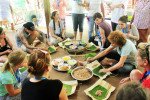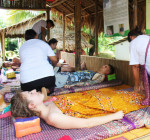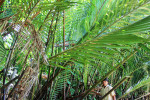Thailand’s Alternative Community Based Tourism

Those who haven’t visited Thailand, and even some of those who have, might think of its tourism industry as being synonymous with full moon parties and massage parlours, but there’s another kind of tourism which is all about exploring the real Thailand. It’s about meeting communities of Thai people, learning about their life and culture, and respecting the environment.
Community based tourism, which is often described as “travelling like a local,” has been going on in Thailand for decades, but is still not as well known as it should be. Community based tourism seeks to uplift local communities by providing them with a sustainable way to support themselves while providing a rich, cultural experience for travellers.
There are many instances where local resources are used in unsustainable and often damaging ways for the sake of tourism. In Thailand particularly, elephant tourism and tiger-temple tourism have been detrimental to local wildlife and neglected the value of these animals and their habitats. Increasingly travellers are looking for alternative experiences that have positive outcomes.
Community based tourism revolves around respect for local people and their customs, it celebrates their traditions and beliefs, builds relationships between different cultures, imparts local wisdom, conserves the environment and protects local wildlife. Communities understand the value of the resources that they have and work to protect them and share them in a sustainable way with visitors.
As part of a community based tourism trip in Thailand, I was fortunate enough to visit three communities in Trat province which were somewhat off of the beaten track. While all of the communities were incredibly welcoming, what really struck me was how different their resources were and how wonderfully they made use of them.
- Hats made from palm leaves
- Local woman cutting palm leaf hats
- Learning to make traditional style food parcels
Nam Chiao Ecotourism Community
The Nam Chiao community have been involved in community based tourism programmes for over 11 years, so are old hands at it. The community is spread out along a canal, where Thai Buddhists and Thai Muslims peacefully co-exist.
Our visit was during Ramadan, so we learned to make Tangme Krop, a sweet candy made from sugar and coconut. This sweet is consumed by everyone in the community but even more so during the fasting period. The locals swear that putting a stick of this sweet in your coffee is far better than any kind of sugar or cream.
The locals here are dedicated to protecting the mangroves and have strict regulations about cutting down mangrove trees, which was often done in the past in order to clear land to build houses. The community replant mangrove trees and re-release small sea crabs that get caught in their fishing nets back into the mangrove swamps to keep the balance of the eco-system.

Chong Changtune Ecotourism Community
The Chong Changtune community is new to the community based tourism movement and is still in the process of setting up their facilities to accommodate tourists, but I thought that they were doing a pretty awesome job already.
The Chong Changtune community are the inventors of the amazingly bizarre chicken coop steams for tourism, which are a twist on the traditional Thai herbal steams. The community also offer different types of massage and run trips down to the river where you can bathe in white mud.
The community here are dedicated to natural and cultural conservation. They are replanting many kinds of plants and herbs in the area which are no longer commonly found in the wild and they replace everything that they pick with a new plant.

- Thai massage with the Chong Changtune community
- Children playing in the white mud river Chongat the Changtune community
Huai Raeng Ecotourism Community
Sitting on the banks of the Trat river, the Huai Raeng community bases their activities around using their natural resources to produce natural products.
I was totally fascinated to discover how pure coconut oil is made, something which I’ve always wanted to know. The process involves grating a coconut and mixing and massaging with water to make coconut milk. Then the liquid is put into a plastic bag and hung up on a tree branch where it separates into solids and the coconut oil.
The community are also the ambassadors of using mangosteen fruit rind to make soap because it is good for the skin. Instead of buying moulds to set the soap, the community use the inside of bamboo, giving the soap a distinctive curved shape.

- Learning the uses of palm leaves with Huai Raeng community
- Making mangosteen soap in bamboo with Huai Raeng community
Different Communities mean Unique Experiences
Community based tourism provide unique experiences that you rarely find otherwise while travelling. Each of the three communities that I had the pleasure of visiting were completely different and I learned something unique from every place. If you are heading to Thailand and want to try a different travel experience, then give community based tourism a go.
My community based tourism exploration in Thailand’s Trat Province was organisation by the Tourism Authority of Thailand in partnership with 7 Greens Thailand and Local Alike.














Sharon
What a truly colourful and enriching experience. I now know how coconut oil is produced.
It’s thanks to bloggers like you that awareness is created about sustainable travel. Something that a lot of people these days want to do, but do not always do the research for.
So thank you for scouting ahead!:)
Amélie @ mostlyamelie.com
Seems like a lovely experience!
Katie Featherstone
It sounds like you’ve found some really unique opportunities here Charlie. I’d love to have a go at making my own coconut oil! I’m glad you’re having a great time in Thailand. :)
Sunny
Hey Charlie,
This is amazing! Love how you prefaced with what community based tourism is… Thailand really could use some help in showing off its other aspects that are much richer and diverse in “Thainess.” I really miss Huai Raeng Village and I am planning to help them bring their all-natural coconut oil to the market.
Do you plan on writing more on the trip in the near future? Also wondering if you’d be down if we guest-post this on our soon-to-be launching blog.
Thanks so much!
From Bangkok,
Sunny
Charlie on Travel
Hey Sunny,
Thanks for reading and glad that you liked my preface :)
All-natural coconut would do really well with the right branding! It’s actually getting very popular over here in the UK.
Yes, I plan on writing more about the trip to Trat with more detail on each place, and on mine and Luke’s travels in Thailand more generally. Lots of to write! And yes, I would love to do a guest post for yo guys – just send me an email or a FB message any time.
From UK,
Charlie
Dr. Biswajit Sinha
Hi Charlie,
My daughter, who studying Cinematography in Hyderabad City, India, wants to participate in short FILM COMPETETION 2019 in Thailaland and the theme is “Living Eco, Living Thainess’. She, along with her partner, wants to make the film based in Trat Province in Thailand. We have started research and found your article is very helpful.
Can you please help in this regard as how the Community’s day to day living is helping in the maintenance of Ecosystem in that area.
Charlie Marchant
Thanks for your comment. That sounds like an extremely interesting and worthwhile project that your daughter is pursuing. I would very much like to see her film when it is complete. Most of my insight is written within this article, including the only interviews I had with local people in Trat Province. I wouldn’t feel comfortable commenting on their behalf. I would recommend she seek out local people from the Province to ask them, those who experience the affects daily.